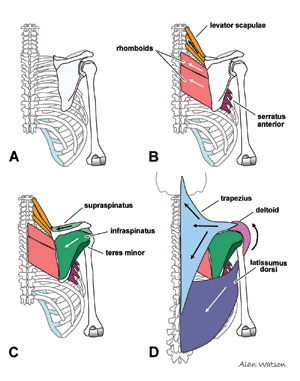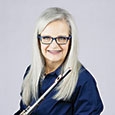 Each year flutists across the country play their instruments while marching (and sometimes running) in intricate patterns, holding the flute out to the side and parallel to the ground. The right shoulder is lifted slightly higher than normal to raise the flute to this horizontal level, and the end of the flute is brought back to keep the instrument in the same plane as the body. The left shoulder is curled forward and around so that the left hand can reach the keys of the flute. In addition, marching band frequently calls for the head to be lifted, which in turn requires the neck to bend backward more than normal. Ouch! I ache just writing about it.
Each year flutists across the country play their instruments while marching (and sometimes running) in intricate patterns, holding the flute out to the side and parallel to the ground. The right shoulder is lifted slightly higher than normal to raise the flute to this horizontal level, and the end of the flute is brought back to keep the instrument in the same plane as the body. The left shoulder is curled forward and around so that the left hand can reach the keys of the flute. In addition, marching band frequently calls for the head to be lifted, which in turn requires the neck to bend backward more than normal. Ouch! I ache just writing about it.
The Problem
As a flutist and physical therapist, I can certainly appreciate what young flutists go through during marching season. When standing at attention and playing, a number of things are occurring in the body. Because the far end of the flute and right shoulder are pulled back, the spine is forced to curve to the left. As the thoracic spine (rib cage level) is not very mobile, the lower lumbar spine and the higher cervical spine (neck) do most of the bending. The left shoulder blade moves forward, and the right is displaced towards the center of the back. The left collarbone, easily felt at the top front of the chest, aids in bringing the left arm and shoulder blade forward.
The issue becomes even more complicated when you consider all the muscles that have to work to achieve and maintain this marching band position. The shoulder joint is one of the most mobile joints in the body and is held in place by a complicated group of muscles, tendons, and ligaments. Many of the muscles that lift and turn the arms arise from the shoulder blade. In order for that to work, the shoulder blade must be stabilized. The muscles that do this are attached to the spine and rib cage.

With the spine and rib cage pulled so far from their normal position asymmetrically, you can see why flutists develop back soreness and fatigue. Take a look (see above) at the levator scapulae, the rhomboids, and the trapezius and imagine the pull they must exert to bring the right shoulder blade back. These same muscles are stretched out on the left side as the muscles of the chest pull the left shoulder blade forward. At the same time, the muscles that attach the shoulder blade to the upper arm, collectively called the rotator cuff, must work to turn the arms as needed and keep them in the right place. Notice the supraspinatus, subscapularis, and teres minor that lie on top of the shoulder blade and the subscapularis that lies underneath it. These muscles along with the deltoids and trapezius lift the arms as they hold the flute up, again in an asymmetrical fashion. In addition, muscles up and down the spinal column are working to hold it in this crooked position.

Consequences
With the right hand cocked backward, the right elbow is more prone to develop lateral epicondylitis, or what is commonly called tennis elbow. Many students have a rounded thoracic spine from either weak core strength or the many hours spent studying or in front of a computer. When they combine this forward posture with the right arm elevation required by the horizontal position of the flute while marching, right-sided shoulder impingement can easily occur. The increased spinal curves in the neck and lower back can cause pain, fatigue, and eventually muscular imbalances. To combat problems such as these, marching flutists need a strong program of not only strengthening and aerobic exercise, but asymmetrical stretches targeting specific muscle groups.
A Well-Balanced Position
 At the opposite end of the spectrum from this situation is the position of artistry. A well-balanced, neutrally aligned set-up for a flutist should be taught as a foundation for solid playing technique. The feet are hip distance apart and at right angles to each other. As seen in the photo (left), the end of the flute is far forward of the plane of the body with the head turned to the left about forty-five degrees. Both shoulders and elbows are down, placing them as close to a neutral position as possible. The flute has a natural angle of droop, which necessitates a slightly asymmetrical embouchure. As the cut of the embouchure hole is typically asymmetrical, this position allows the flutist to match his flute better. The spine is much more aligned in this position; only the cervical (neck) area is rotated. A rightward tilt of the head, seen so often in flutists, can be minimized if not eliminated using this stance. This adapts easily to a seated position, with the chair at a forty-five degree angle to the music stand.
At the opposite end of the spectrum from this situation is the position of artistry. A well-balanced, neutrally aligned set-up for a flutist should be taught as a foundation for solid playing technique. The feet are hip distance apart and at right angles to each other. As seen in the photo (left), the end of the flute is far forward of the plane of the body with the head turned to the left about forty-five degrees. Both shoulders and elbows are down, placing them as close to a neutral position as possible. The flute has a natural angle of droop, which necessitates a slightly asymmetrical embouchure. As the cut of the embouchure hole is typically asymmetrical, this position allows the flutist to match his flute better. The spine is much more aligned in this position; only the cervical (neck) area is rotated. A rightward tilt of the head, seen so often in flutists, can be minimized if not eliminated using this stance. This adapts easily to a seated position, with the chair at a forty-five degree angle to the music stand.
Both the marching band stance and the position of artistry should be taught to young flutists well before marching season. They should not use the marching band stance when they are in the band room sitting in a concert band set-up to practice the marches they will be playing on the field. Their flutes should be gently angled downward, their chairs; their bodies should be at a right angle to the stand; and their heads should be turned to the left. Save the marching position for outside.
Students should have a good understanding of the differences between the two positions and know how to switch between them. A good way to differentiate these two positions is to practice going back and forth between them. Start in the marching position, and then while keeping the head, arms, and flute stationary, turn the right hip outward to the right, bringing the right foot back and pointing to the side. Now you are in the position of artistry. Return to the marching band position.
Further Remedies
The awkwardness and fatigue factor of the marching position for flutists can be avoided in several different ways. The most obvious is to not use flutes at all in marching bands. A radical idea, but the flute sound is not well suited to a football stadium. Piccolos can at least be heard and are much easier to manage. Flutists can use this as an opportunity to learn a second instrument, such as the lyre or some other member of the percussion family. (I learned to twirl so that I could avoid marching with my flute.) Flag bearers are another alternative. If flutists do march with a flute, they should buy a second-hand curved headjoint. The reach is lessened significantly, and the flute won’t stick out to the side as much. As with the piccolo, there is also less chance of running into another bandsman and less strain on the arms and upper back. Marching band directors could also use the position of artistry when the band plays in a stationary formation.
Flute teachers should educate both their students and band directors about these different positions and the physical problems that can arise. With more awareness of the difficulties of the marching position, hopefully band directors and the judges of marching competitions will become more open to providing alternatives for marching flutists.






